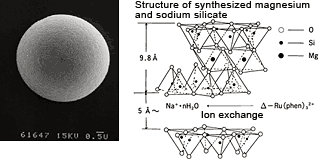- HOME
- Products
- HPLC Columns
- Ceramospher (Chiral)
|
|
|
|
|
|
|
|
|
|
|
|
Ceramospher is coined from "ceramic" and "sphere." This is a completely new type of column for optical separation where the optically active metal complex Δ-Ru(phen) 32+(phen=1,10-phenanthroline) is adsorbed to porous spherical ceramics by cation exchange. |
|
|
 |
The clay mineral used for the chromatographic support has a multilayer structure. Analyte molecules are supposed to enter narrow gaps between the layers, and to fit into environments where three-dimensional interactions for chiral recognition take place. When trying many chiral compounds, probability of successful optical separation is much higher than those of conventional chiral columns. |
|
|
|
Difference between RU-1 and RU-2 |
|
|
RU-2 packing material is created from RU-1 by further special hydrophobic treatment. Consequently, Ceramospher (Chiral) RU-2 allows the use of aqueous (reversed phase) mobile phases. |
|
|
|
|
Features |
|
|
· Excellent separation hit rate
|
|||
|
|
|
|
· Excellent pressure resistance (20 MPa) |
|
|
· Stable in a wide temperature range |
RU-1 RU-2 |
20 to 60°C (methanol type) 15 to 60°C (water/methanol type) |
|
|
· Also available outside Japan |
|
|
|
Property values |
|
|
Type | Particle size (µm) | Specific surface area (m 2/g) | Acceptable pH | Pore size (nm) |
|
|
RU-1 | 5 | 300 | 3~6.5 | 4 |
|
|
RU-2 | 5 | 300 | 3~6.5 | 4 |

